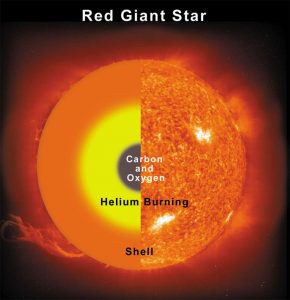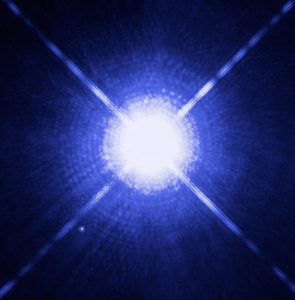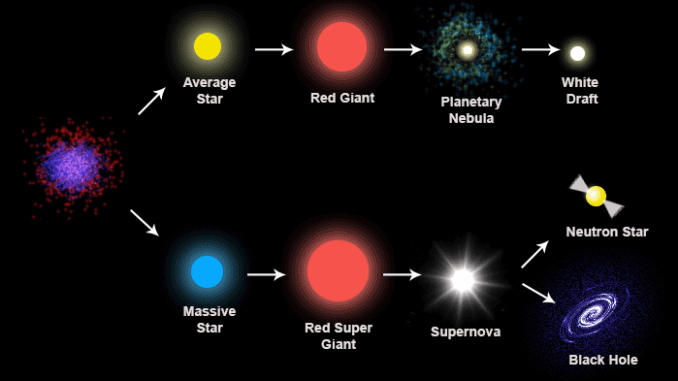Life Cycle of Stars 2 is for GCSE Physics students.
You can find a short version in our revision notes.
In our last blog we saw how stars are born and how they shine.
We learned that within every star there is a battle between gravity and radiation from the core.
In this blog, we’ll see how that conflict is resolved in the death of stars.
Stars may live a long time but their deaths are as inevitable as our own.

Crab Nebula, M1. Credit: NASA/ESA, Hubble Space Telescope
Cause of Death
Nuclear fusion reactions in the core of a star convert hydrogen to helium.
This reaction produces enormous amounts of energy.
This energy makes stars shine.
The energy creates radiation pressure pushing out from the core.
This pressure is balanced by the force of gravity squeezing inwards on the star.

Whilst the fusion reactions continue, radiation and gravity are in balance.
The star is stable, shining as a main sequence, ordinary star.
But when the hydrogen in the core is used up, things get out of balance.
With no radiation pressure, gravity takes over.
The star dies.
Sun-size stars
When the hydrogen in the core is exhausted, fusion reactions fail.
Gravity takes over and the star is squeezed inwards.
This collapse heats up the core and new fusion reactions begin.
Helium fuses to carbon, carbon makes oxygen, oxygen creates nitrogen.

Red giant interior. Credit: NASA
These new reactions push the star out bigger than before.
The star swells to 30 times its previous size.
The heat then spreads over a large area.
The star becomes cool and red.
It is a red giant, a dying star.

Red giant star. Credit: NASA
The red giant is not quite dead.
The pressure from the core continues to push outwards.
The outer layers of the star are blown away in a stream of hot gas.
The gas forms a bubble around the dying star.
This stage is called a planetary nebula. It looks a bit like a planet in a small telescope.

Ring Nebula, M57
Credit: NASA, ESA, and C. Robert O’Dell (Vanderbilt University).
When the outer layers of gas have blown away, only the core remains.
It glows hot and white. It is a white dwarf, a dead star.

White dwarf. Credit: NASA
Its heat will radiate into space and these stars will become cold black embers.
Superstars
There are rare stars that are massive, hot and blue.
These are blue giants, the superstars of the galaxy.

Blue giant star. Credit: NASA
Blue giants burn up their hydrogen quickly.
Their lives are brief, only around 20 million years.
When the core runs out of hydrogen, the fusion to helium stops.
Gravity takes over and the star begins to collapse.
But this collapse heats up the core and it becomes hotter than before.
Now a series of fusion reactions see heavier elements created in layers in a bigger core.
They include carbon, oxygen, neon, silicon and elements up to iron.

Fusion layers in a red supergiant star.
Credit: Penn State Astronomy & Astrophysics
The radiation from these new fusion reactions pushes the star out bigger than before.
It may become 100 times bigger than its blue giant size.
It is a red supergiant, perhaps a billion kilometres across.

Red supergiant star. Credit: NASA
This monster star is living on borrowed time.
The central core is filling with iron ash.
Even at the colossal temperatures in the star’s core, this iron is inert, it cannot fuse.
Eventually the iron core becomes so big that it cannot hold up the superstar.
Gravity takes over for the final time.
The huge star collapses in a few seconds.
The collapse crushes the core.
Collapsing outer layers of gas hit this hard core and rebound violently.
The outer layers of gas are blasted into space in a gigantic explosion.
It is a supernova, an exploding star.

Crab Nebula, supernova remnant. Credit NASA/ESA/Hubble
A supernova explosion is so powerful that it can shine brighter than all the stars in an entire galaxy.
A supernova is one of the most violent events in the universe.
Supernova remnants
Gravity crushes the core of the star almost beyond belief.
One of two objects can result from this gravitational collapse.
Neutron star
Atoms are crushed together. Protons and electrons join to make neutrons.
The core becomes a ball of neutrons packed closely together.
It is a neutron star.

Image Credit: X-ray: NASA/CXC/UNAM/Ioffe/D.Page, P. Shternin et al; Optical: NASA/STScI;
Illustration: NASA/CXC/M. Weiss
This dense ball of matter is small, only 20 kilometres across.
But it is dense, with the mass of three Suns.
One teaspoonful of neutron star would weigh five billion tons!
Wow, that’s heavy!
Black hole
But gravity may have a final trick up its sleeve.
If the core that remains is more than five times the mass of the Sun, the collapse becomes complete.
The neutron star collapses in on itself.
It is crushed into a pinpoint called a singularity.
This infinitely tiny point weighs five times more than the Sun.
Its gravity is so great that nothing is fast enough to escape it.
Not even light can escape.
The singularity is surrounded by a sphere of darkness, perhaps a kilometre across.
This ball of darkness is a black hole.

Computer-simulated image of a black hole
Image Credit: NASA, ESA, and D. Coe, J. Anderson, and R. van der Marel (STScI)
Cosmic recycling
Stars are chemical factories.
Stars like our Sun turn hydrogen into helium, carbon, oxygen and nitrogen,
Massive stars produce these elements and also silicon, aluminium and iron.
When stars die, they blow these new elements into space.
They are the raw materials for new stars – and planets.
When a superstar explodes as a supernova, even heavier elements are made.
They include gold, silver and lead.
Stars turn hydrogen into all the natural elements that make our Universe.
The death of stars provide new stuff for stars and planets.
Our Sun was one of them. The planets were made from material made in stars.
Our Earth, and life on it, came from long dead stars.
We are all made of stardust.
Summary

Life cycle of stars. Credit: NASA
So there is the life story of stars.
All stars are created in nebulae and made from hydrogen gas.
Gravity compresses the gas and the temperature rises.
They shine because of nuclear fusion in their cores.
When they run out of fuel, stars die.
Ordinary, sun-size stars swell to become red giants.
These giants blow away their outer layers to die as a white dwarf star.
Big stars, 8 to 10 times the mass of the Sun, live brilliant but short lives.
They are also born from hydrogen gas.
They burn up the gas at a tremendous rate.
When they die, they grow to become red supergiants.
These gigantic stars explode in supernovae.
They die as either a dense neutron star or black hole.
The death of stars creates new, heavy elements.
These materials seed space with the building blocks for new stars, new planets – and life.
The author: Dennis Ashton is a Fellow of the Royal Astronomical Society and a Wonderdome presenter.
Would you like to hear more Astronomy news?
Do you want to to find out about our upcoming public events?
Follow WonderDome Portable Planetarium on Twitter and Facebook or go to our web site wonderdome.co.uk!

